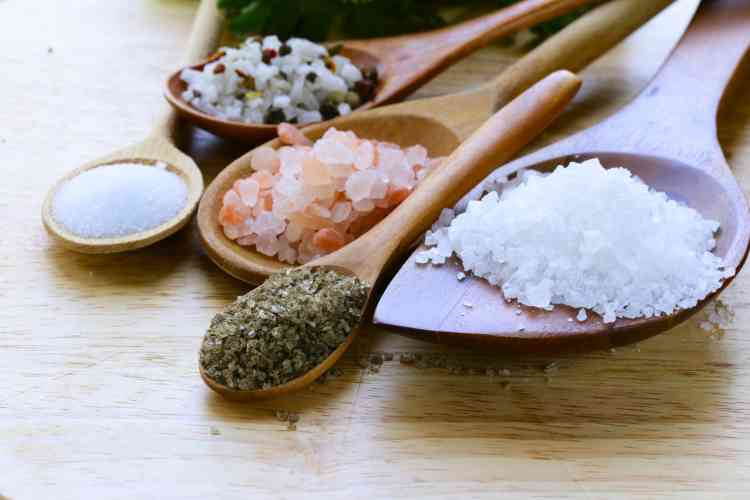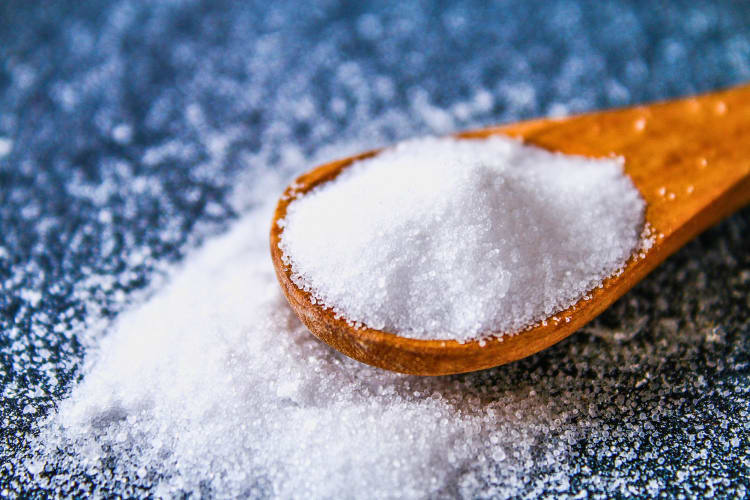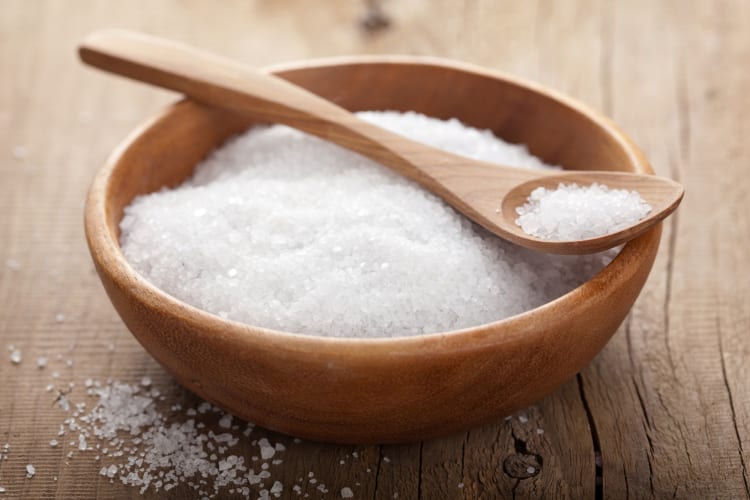10 Healthiest Salts According to a Nutritionist in 2025

While it's no mystery that the body needs sodium for key functions, choosing the healthiest salts for your needs can be a tricky task. As the Centers for Disease Control and Prevention (CDC) explains, when consumed appropriately, salt helps maintain electrolyte balance and supports overall health. However, overconsuming salt can lead to issues like high blood pressure, increasing the risk for stroke and heart disease.
While portion control and staying within the daily recommended sodium intake (1,500 to 2,300 milligrams per day, according to the American Heart Association) is the primary way to prevent overconsumption, preparing meals at home and keeping serving sizes moderate are also important strategies.
Yet, a quick glance at the selection available at the store is enough to make your head spin as you try to determine which are the healthiest salts among them all. Cost and availability aside, have you ever wondered what salt is best for you? Out of all the salts peppering the market, how do you determine which is the healthiest salt?
This helpful rundown of the 10 healthiest salts reveals which types you should stock up on. Our in-depth, nutritionist-reviewed guide also provides suggestions for working them into your daily diet and explores the benefits and drawbacks of each to help you identify the healthiest salt for your particular needs.
Jump to Section
- The 10 Most Healthy Salts To Cook With
- What Is the Healthiest Salt?
- What Is the Healthiest Salt Substitute?
- How We Choose the Healthiest Salts
The 10 Most Healthy Salts To Cook With
1. Himalayan Pink Salt
At first glance, you might mistake Himalayan pink salt for miniature rose quartz crystals. In reality, these colorful grains are considered to be among the healthiest salts, known for their distinctive rosy color from trace minerals like iron, which affect flavor and appearance rather than providing meaningful nutrition.
As WebMD explains, this healthy salt contains trace minerals that influence flavor and color, though the amounts are too small to provide meaningful health benefits. Because it undergoes minimal refining, Himalayan pink salt offers a less processed choice for cooking, with no proven nutritional advantage over other salts. Do be careful when shopping, however, as this salt can cost more than table salt, depending on where you make your purchase.
In terms of uses, you can add this healthy type of salt to almost any dish that requires salt, but do note that the salt crystals are larger than table salt. Popular recipes with this healthy salt include herb-crusted lamb lollipops, where the larger salt crystals work well with the rosemary and thyme crust, and raw wraps, where this type of salt perfectly brings out the flavors of the vegetables.

2. Regular Table Salt (Iodized)
Regular table salt, or iodized salt, is likely the type you're most familiar with. Its added iodine is especially important. As the Cleveland Clinic explains, iodine is required to make thyroid hormones, which support thyroid health and prevent enlargement of the thyroid gland — a condition known as a goiter.
While goiters were once relatively common in the U.S., fortifying table salt with iodine has helped ensure adequate daily intake and significantly reduced the prevalence of this condition. The wide availability of iodized salt as a general-use seasoning makes it one of the healthiest salts for supporting adequate iodine intake.
On the downside, it’s a very basic salt, which means its flavoring power is limited to simple saltiness rather than lending more intriguing flavors like other salts can. Despite this, this type of salt is one of the most affordable on the market, so if you're aiming to make cheap and healthy meals, it can be a good choice that won't break the bank.

3. Sea Salt
If consuming highly processed foods is a concern for you, you might investigate sea salt as one of the healthiest salts to include in your diet. Unlike many salts that are mined, sea salt is produced by evaporating seawater.
This process allows the finished product to retain more of the trace minerals like magnesium, zinc and potassium. These trace minerals influence taste and texture, but they do not offer significant nutritional benefits.
However, the sodium content in sea salt is still an aspect to be cautious with, as it will have the same impact on your body as any other salt you consume. As the American Heart Association points out, the trace minerals found in sea salt, such as potassium, can be obtained more effectively from other, healthier foods. Therefore, sea salt should be used in moderation for flavor, not as a significant source of nutrients.
If you're searching for the best salts for cooking among the healthiest salts on this list, this is a great choice. Sea salt is an especially good option if you want to enhance the flavors of your dish. It elevates subtle flavors well, such as those found in lean meats and vegetables.
It also works well in marinades and rubs, such as jerk chicken marinade, with seafood dishes like blackened shrimp, and in plant-based recipes, such as black bean hummus. It's a great finishing salt as well, making sea salt one of the healthiest salts that's also a culinary must-have.

4. Kosher Salt
Though many versions of kosher salt adhere to true kosher standards, the name arises from its original use in drawing blood out of meat to prepare it for cooking, a process called "koshering." The coarser crystals give kosher salt a gourmet feel that can enhance the texture of a dish.
It's important to note that kosher salt doesn't usually contain iodine, so this won't be the healthiest salt for you if you're searching for the best iodized salt.
The larger crystals that characterize this salt mean you'll get less salt per teaspoon than with table salt. This can be beneficial, as you may be encouraged to use less salt overall, minimizing your sodium intake. However, if you add salt to dishes based on taste instead of measurement, you'll likely consume a similar amount of sodium when switching from table salt to kosher salt.
Despite this, many find larger-grained kosher salt better for many cooking applications than table salt. For example, a sprinkle of this healthy salt over dishes like accordion potatoes or air-fryer zucchini chips will put just the right tingle in your taste buds while lending a bit of extra crunch.

5. Celtic Sea Salt
Gathered through solar evaporation from clay ponds located on the coast of northwestern France, Celtic sea salt is a less processed salt that retains trace minerals. The grains impart a flavor that’s been described as “oceanic umami” to whatever you sprinkle them on.
Since Celtic sea salt absorbs elements from the region where it's harvested, each batch has a unique composition reflecting its local environment. The more complex flavor and irregular grain size can help add flavor with smaller pinches, though it still contains sodium and should be used in moderation.
This is one of the best salts to use in recipes like tuna tataki or grilled shrimp tacos, as the salt's oceanic flavor pairs well with these proteins from the sea. Additionally, you may have already even seen this salt on social media, with influencers suggesting that adding Celtic sea salt to a glass of water can improve hydration. However, as Medical News Today confirms, there is no science to back this up.
Despite this specific trend not being correct, Celtic sea salt remains one of the healthiest salts to use in dishes that require it, but keep an eye on how much you are using, as overuse can still contribute to high sodium intake, which is linked with increased blood pressure and related health concerns.

6. Smoked Salt
The earthy goodness of smoked salt doubles up on the flavor factor, providing a salt you can use sparingly while still adding taste to dishes like corn cakes and vegan tacos. To achieve the smoky effect, salt is smoked for up to two weeks using aromatic barks ranging from apple to hickory, with each finished salt offering its own unique profile.
Smoked salt isn’t a uniquely healthy salt since it contains the same sodium as regular varieties, though its bold flavor may help you use less and season dishes more mindfully. If you shop for smoked salt, be sure to look for the authentic version rather than salt infused with smoke flavoring, which may not align with your idea of a low-processed, healthier salt.

7. Fleur de Sel
Fleur de sel is a French version of sea salt that appears in many upscale European recipes. As you may have guessed, it's frequently used in recipes for French food, including sweet recipes.
Its elegant flake resembles snow and imbues it with a light texture and delicate crunch. The name translates to “flower of salt,” a reference to the crystalline patterns the flakes take on.
As a more high-end option for well-made dishes, you may encounter fleur de sel in gourmet cooking classes near you, where expert chefs are likely to introduce you to new ways to flavor food with minimal use of unique salts.
This is another costly salt that you may need to shop carefully for to avoid spending too much. It may also not be available in your regular grocery store, often being sold exclusively in gourmet cooking shops and the most expensive grocery stores in the world.

8. Grey Salt
Grey salt, or sel gris, is another French salt that stems from the gathering of fleur de sel, though grey salt touches the bottom of the collection pan during harvest and attains its characteristic ashy hue.
A coarse salt that retains more moisture than fleur de sel, grey salt can be counted among other kosher salt substitutes as a finishing salt to decorate and flavor dishes without drying out the food.
Its coarse texture works well as a finishing salt, which some cooks find easier to sprinkle lightly. You may need to shop online for this specialty, healthy salt, as not all chain grocers are guaranteed to keep it in stock.

9. Himalayan Black Salt
Himalayan black salt, also known as kala namak, is a highly sulfurous salt, which gives it a distinctive egg-like flavor. In Ayurvedic tradition, it is used for digestive support and providing trace minerals, but these uses are based on traditional practice rather than strong scientific evidence. It's a popular add-in for vegans trying to recreate the flavor of egg dishes without using actual eggs.
Plant-based eaters are likely to discover uses for Himalayan black salt while taking online cooking classes that elevate garden-variety vegetable dishes into the realm of gourmet artistry without leaning too heavily on salt content for flavor.
Although it contains trace minerals such as iron and magnesium, these are present in very small amounts, so they are unlikely to provide significant health benefits. When it comes to finding the healthiest salt, the key lies less in the type and more in overall moderation and balance within your diet.

10. Red Hawaiian Salt
If you’ve never heard of red Hawaiian salt, you may be missing out on one of the most intriguing salts in the world. Also known as alaea salt, it gets its rich, rusty color from volcanic clay and is a staple in traditional Hawaiian cuisine.
Often chosen for its minimal processing and distinctive minerals from the clay, it offers little nutritional difference from other salts. While it’s not necessarily the healthiest salt, many appreciate its earthy flavor, striking color and cultural significance — making it a unique option among less-refined varieties.

What Is the Healthiest Salt?
All salts contain sodium, so choosing the healthiest salt largely depends on factors like grain size, iodine content, processing and how much you use, rather than significant nutritional differences.
Less processed options, such as Celtic sea salt or Himalayan pink salt, retain trace minerals and have coarser grains, which can provide more flavor and may help some cooks use smaller amounts. However, these minerals are present in minimal amounts and do not significantly impact overall health.
For overall wellness, iodized salt is a practical choice because it provides iodine to support thyroid function, is affordable and widely available. Taste, cost and culinary function are also important, so many people keep a small selection of salts for different uses. When figuring out how to start eating healthy, it’s crucial to know just how much salt to include in your diet, and ultimately, moderation is key.
Even the healthiest salt has the same sodium content as other salts, and limiting overall sodium intake is far more important for heart health than the type of salt you use. If you’re wondering, “What salt is best for you?”, consulting a healthcare professional can help guide how to incorporate the healthiest salts into your diet safely.

What Is the Healthiest Salt for High Blood Pressure?
All types of salt contain sodium, and excess sodium intake raises blood pressure in most people. Even the healthiest salt can affect blood pressure if used in large amounts.
Potassium-enriched salt substitutes can help reduce sodium intake and may support blood pressure control for some adults, especially those with hypertension. However, they should be used cautiously by those with kidney disease or taking certain medications.
Iodized salt supports thyroid health but does not regulate blood pressure. Some people choose Himalayan pink salt for its texture or taste, which might encourage lighter use, but it contains nearly the same amount of sodium as table salt and has no proven benefit for lowering blood pressure.
Ultimately, finding the healthiest salt for your needs comes down to reducing sodium overall. Salt substitutes or smaller portions can help, but moderation remains key for maintaining healthy blood pressure. You should always consult with a healthcare professional when making decisions about adopting the healthiest salt practices for your needs.

What Is the Healthiest Salt Substitute?
Even the healthiest salt still contains sodium, which may need to be limited for heart or kidney health. Salt substitutes, often made from potassium chloride, provide a salty taste without sodium and can be a practical alternative for those looking to reduce sodium intake. While they may not perfectly replicate table salt, they are considered one of the healthiest salt replacements for people aiming to reduce sodium.
People with kidney disease or on certain medications should check with a clinician before using potassium-based substitutes. If you want to reduce salt without compromising taste, you can also experiment with herbs and spices to enhance your favorite dishes. A few flavorful additions include:
- Onion Powder: A lighter flavor than real onions in a powder form that incorporates easily into any savory dish.
- Garlic: In powdered or fresh form, this aromatic addition provides a zesty tingle that wakes up your taste buds.
- Paprika: The gently peppery essence adds complexity to meats and vegetables to provide umami goodness.
- Cumin: With a smoky spirit and intriguing exotic personality, it’s a great compromise for salt in beef and chicken dishes, as well as root vegetable recipes.
- Rosemary: Sprightly notes of lush greenness and a touch of vibrant vapor lift everything from fish to chicken to potatoes.
- Dill: This refreshing herb makes an outstanding option if you’re looking for flavorings to serve as celery salt substitutes or replacements for other green-leaning salt-based additives.
Sodium is present in many foods, so choosing the healthiest salts starts with understanding your dietary needs and health goals. Even the healthiest salt should be used in moderation. By combining small amounts of salt with herbs, spices and aromatic vegetables, you can create rich, satisfying flavors while minimizing sodium intake.

How We Choose the Healthiest Salts
The team at Cozymeal is passionate about connecting our audience with one-of-a-kind culinary experiences and providing them with a range of food-related content, including nutrition content. From guides to the healthiest Greek yogurt to articles outlining the healthiest energy drinks and the best low-sodium fast food, we have a wealth of experience creating health-based content.
These guides are created by conducting thorough research and consulting with Jessica O'Shea, a Registered Nutritionist (ANutr) with the Association for Nutrition, to produce articles that are factually accurate, informative, and most importantly, helpful to you, the reader.
To create this guide to the healthiest salts, we followed that process again: researching what makes a healthy salt and uncovering the 10 best options on the market, including those that are widely available at the grocery store and gourmet healthy salts that are ideal for the health-focused culinary enthusiast.
Finally, we had the content reviewed by a nutritionist to ensure we only recommend the healthiest salts and correctly highlight both the benefits and drawbacks of these ingredients.

Choosing the healthiest salt for your specific needs shouldn’t be a guessing game. It’s important to consult with your physician or nutritionist to identify the best option for your health.
Once you know which salt is the healthiest for your purposes, you can start experimenting with it in your favorite dishes. This gives you a chance to explore new ways to add flavor while keeping sodium in check.
For even more ways to explore your favorite foods, check out other experiences happening on Cozymeal.



FOOD FOR THOUGHT?
Join the conversation.